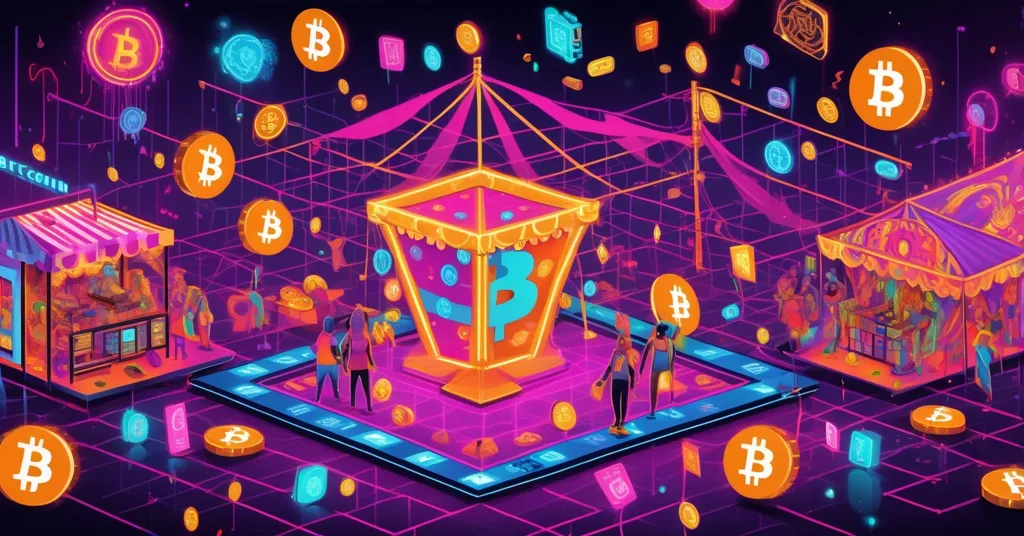NFTs vs. Memecoins: Digital Gold or Dangerous Gambles in 2025 Crypto Boom?

NFTs vs. Memecoins: Digital Assets or Risky Gambles in 2025?
The crypto market has roared past a staggering $4 trillion valuation, fueled by a historic U.S. regulatory breakthrough in July 2025. Amid this whirlwind, non-fungible tokens (NFTs) and memecoins have emerged as two of the most polarizing digital assets, often mistaken for interchangeable hype bubbles despite their stark differences. Let’s slice through the clutter, break down what defines each, weigh their potential against their pitfalls, and figure out if they’re genuine tools for a decentralized future or just shiny traps for the gullible.
- Fundamental Split: NFTs are unique blockchain assets tied to ownership of specific digital items, while memecoins are fungible tokens driven by memes and raw speculation.
- Regulatory Shift: The GENIUS Act of 2025, the first U.S. federal stablecoin law, has spiked market legitimacy and value overnight.
- Risk Check: NFTs hint at innovation in ownership but carry hurdles; memecoins often play out as pure gambling with little staying power.
The GENIUS Act: Crypto’s Legitimacy Leap
On July 18, 2025, President Donald Trump signed the GENIUS Act into law, a groundbreaking piece of legislation greenlit by Congress just a day earlier. This marks the first federal framework in the U.S. to regulate stablecoins—digital currencies pegged to real-world assets like the dollar—with strict reserve requirements and oversight to tame the market’s infamous volatility. The impact hit like a thunderclap: the total crypto market cap surged beyond $4 trillion, a milestone that screams growing mainstream acceptance. Trump, self-styled as the “Crypto President,” isn’t just waving the flag; his World Liberty Financial platform is diving in with a stablecoin (USD1), NFTs branded as Trump Digital Trading Cards, and a memecoin called Official Trump. Is this a serious push for blockchain adoption or a glitzy political stunt? Hard to say, but it raises eyebrows about whether political involvement in crypto fuels innovation or risks tainting decentralization with partisan baggage, potentially inviting harsher regulatory crackdowns. For more on the implications of this legislation, check out this detailed breakdown of the GENIUS Act 2025.
NFTs: Digital Ownership or Overblown Hype?
Let’s start with NFTs—non-fungible tokens. These are unique digital assets recorded on a blockchain, a decentralized, unchangeable ledger that tracks transactions across a network of computers. Picture an NFT as a digital title deed, proving you own a specific item—maybe a piece of digital art like a Bored Ape Yacht Club image, a virtual sneaker, or a chunk of metaverse real estate. Each NFT has a distinct identifier, often part of a limited collection, setting it apart from standard cryptocurrencies. Kristen Mierzwa, Head of Digital Assets at FTSE Russell, nails the distinction:
“The easiest way for anyone to identify if a digital asset is a memecoin or an NFT is to see if the asset has a token symbol… If you see an image with a unique ID like #221 of a collection, it is likely an NFT.”
The magic of NFTs lies in their ability to cement ownership and authenticity in a world where digital copying is a click away. Imagine snagging an NFT as a concert ticket that also unlocks VIP perks—neat, until the fine print bites. Since their 2021 explosion, NFTs have shown glimmers of utility in art, gaming, and even digital identity, with platforms like SuperRare curating premium digital works. John Crain, CEO of SuperRare, sees a cautious but promising road ahead:
“I think we’re going to see slow, steady institutional adoption of the NFT digital asset class, making them good investments.”
But don’t get too cozy. The U.S. Securities and Exchange Commission (SEC) is still fumbling with whether some NFTs count as securities—especially when split into shares or pitched as profit generators. Then there’s the IRS, which in March 2023 (Notice 2023-27) tagged certain NFTs as “collectibles,” slapping them with a punishing 28% capital gains tax compared to the 15-20% for most crypto trades. That’s a wallet-draining surprise for many. For deeper insight into this tax classification, refer to the IRS guidelines on digital assets. With institutional interest still dragging its feet, NFTs are far from a sure thing, even if they align with blockchain’s ethos of disrupting gatekeepers and redefining ownership.
Memecoins: Internet Jokes or Financial Sinkholes?
Switch gears to memecoins, and you’re in a different jungle. These are fungible tokens—interchangeable like Bitcoin or Ethereum—but often built on nothing more than internet memes, social trends, or sheer absurdity. Dogecoin, spawned from a Shiba Inu joke, leads the pack, while names like Fartcoin push the ridiculousness meter to eleven. Unlike NFTs, there’s no uniqueness; memecoins live on hype, community zeal, and random celebrity tweets that can spike prices—until the inevitable crash. Shane Molidor, CEO of Forgd, lays it bare with a brutal takedown:
“Memecoin markets largely function like gambling, and are extremely unsustainable today… Every memecoin creator has every incentive to extract maximally; they aren’t worried about customers returning to their casino.”
Market trends show money pouring into altcoins, including memecoins, Ethereum, Solana, and XRP, as investors chase juicier returns than Bitcoin’s steadier climb during bull runs. William Quigley, co-founder of WAX and Tether, predicts a memecoin mania peak in 2025, echoing the NFT craze of 2021:
“I expect 2025 to be a meme coin market high year parallel to the digital asset bull run akin to when the NFT market exploded during the first part of 2021.”
Here’s the kicker: most memecoins die after the buzz fades. Look at Argentine President Javier Milei’s failed token attempt for a textbook flop. Regulators, like the European Central Bank under the MiCA framework, are itching to clamp down, especially with politically charged tokens like Trump’s Official Trump whipping up volatility. Some, like Sergio Hamza of Coincu, dream of a memecoin evolution through tech:
“With agentic financial automation and independent AI tools, we could see memecoins evolve from pure speculation into a foundation for digital financial independence.”
Let’s not sugarcoat it—most memecoins are digital snake oil peddled by carnival barkers looking to fleece the crowd. Still, there’s a flip side: they’ve dragged countless newbies into crypto through humor and viral charm. Dogecoin turned Reddit memes into a gateway to blockchain—sketchy as hell, but doesn’t that raw exposure speed up adoption in its own messy way? For a broader look at what defines these tokens, explore this overview of meme coins.
Speculation Face-Off: NFTs vs. Memecoins
Both NFTs and memecoins catch heat for being speculative traps, but the risks aren’t identical. NFTs can have real utility—think digital art with cultural weight or game assets with actual function—offering a stake in blockchain’s future of ownership and transparency that we root for. Their speculative stink comes from status-driven prices (million-dollar pixel apes, seriously?) and murky legal ground. Memecoins, on the other hand, are usually straight-up bets, with value tied to social media noise and zero substance. Creators often pump, dump, and ghost—hardly the decentralized rebellion we’re fighting for. Yet, writing them off completely misses their niche role. They’re the jester of crypto, often crashing hard, but sometimes pulling a curious crowd into the broader blockchain circus. If you’re curious about community perspectives on these risks, check out this discussion on investment pitfalls.
Bitcoin’s Anchor Amid the Chaos
While NFTs and memecoins duke it out in the hype arena, Bitcoin stands as the unshakeable core of decentralization. Unlike NFTs with their experimental quirks or memecoins with their clown-car energy, Bitcoin’s fixed supply of 21 million coins and rock-solid network make it the gold standard of crypto. It’s not about chasing trends; it’s a direct challenge to centralized finance, embodying the freedom and privacy we champion. That said, altcoins like Ethereum, the backbone of most NFTs, and Solana, a memecoin playground, fill gaps Bitcoin doesn’t—think smart contracts or faster, cheaper transactions. We lean Bitcoin maximalist, no question, but we can’t deny these ecosystems spark innovation, even if they’re riddled with scams and noise. For a perspective on Bitcoin’s influence in these trends, take a look at this analysis of its role.
Legal and Tax Quagmire: Know the Game
For those just dipping toes into crypto, here’s the gritty reality of the legal and financial maze. A blockchain is a public, uneditable record of transactions—every NFT purchase or memecoin swap is logged for good. The SEC wields the Howey Test to decide if a digital asset is a security, like a stock: if you’re putting money in expecting profits from someone else’s grind, it might be regulated. Memecoins often skate by as quirky “collectibles,” while NFTs can get snagged if marketed as investments. On taxes, the IRS treats both as property—every trade or sale is a taxable event, with capital gains calculated in dollars at the time of the deal. Some NFTs, flagged as collectibles, get hammered with a 28% rate, higher than the usual 15-20% for crypto. It’s a headache, and with the GENIUS Act setting a precedent for tighter rules, expect more oversight. In Europe, the MiCA framework could force NFT creators and memecoin platforms into costly compliance, potentially crushing smaller outfits. To understand broader community reactions to this legislation, see this discussion on the GENIUS Act’s impact.
Don’t Get Scorched: Practical Tips
Before you jump into the next NFT drop or memecoin moonshot, arm yourself with a no-BS checklist to avoid getting burned:
- NFTs: Dig into the project’s team—are they credible or shadowy nobodies? Look for real utility (does the NFT do something useful?) and a strong community. Dodge any “guaranteed returns” hype—that’s a glowing SEC warning sign.
- Memecoins: Spot red flags like anonymous devs, wild price predictions, or “get rich yesterday” vibes. If it’s pure hype with no meat, bolt. Stick to known players like Dogecoin if you’re testing waters, and only risk what you can afford to flush.
- Tax Prep: Log every move—Uncle Sam doesn’t forgive forgetfulness. Use crypto tax tools if you’re trading often, and brace for a steeper hit on NFTs classed as collectibles.
Peering Ahead: What’s the Endgame?
Looking down the road, NFTs could reshape how we handle digital identity, real estate, or even secure voting if tech bottlenecks like scalability—processing millions of transactions without choking—and regulatory fog clear up. Real-world experiments, like Ticketmaster dabbling in NFT-based ticketing, point to utility over mere speculation. Memecoins, unless hooked to authentic community or charity drives (think Dogecoin’s old fundraising tricks), will likely stay a carnival act—a digital dice roll for the daring or daft. The GENIUS Act’s stablecoin focus might spill over, with reserve rules and reporting mandates gutting shady memecoins while nudging NFTs toward function over frenzy. Globally, frameworks like MiCA hint the free-for-all days are fading—great for stability, maybe rough on raw innovation. For a deeper dive into the potential market effects of this regulation, explore this analysis of GENIUS Act outcomes.
Key Questions and Takeaways
- What’s the core difference between NFTs and memecoins?
NFTs are unique digital assets on a blockchain, verifying ownership of specific items like art or virtual goods, while memecoins are interchangeable tokens fueled by internet memes and speculation, often with no real value. - Why is the GENIUS Act a game-changer for crypto in 2025?
Signed into law in July 2025, it’s the first U.S. federal regulation of stablecoins, boosting trust and pushing the market cap over $4 trillion, a clear sign of mainstream traction. - Do memecoins offer any real value to the blockchain space?
Most are gambling pits with creators cashing out fast, but they’ve onboarded droves of new users to crypto through viral humor, serving as a chaotic entry to decentralization. - Can NFTs become dependable investments or tools?
They hold potential in art, gaming, and digital identity with slow institutional uptake on the horizon, though steep taxes up to 28% and legal ambiguity keep risks high. - How do taxes and regulations mess with holding these assets?
The IRS taxes both as property with capital gains on every deal, hitting some NFTs harder at 28%; SEC and MiCA rules could tighten compliance, especially for speculative plays. - Where does Bitcoin stand in the NFT and memecoin frenzy?
Bitcoin remains the decentralized bedrock, prioritizing scarcity and freedom over the speculative chaos of NFTs and memecoins, though altcoins like Ethereum fuel innovation in areas Bitcoin sidesteps.
As we navigate this turbulent corner of crypto, NFTs dangle a flawed but tantalizing vision of blockchain’s power to redefine ownership and dismantle traditional barriers in art, gaming, and beyond. Memecoins, with all their viral swagger, are largely a neon-lit warning of financial recklessness—fun until the floor drops out. We’re all about accelerating a decentralized future and smashing the status quo, but not by backing scams that prey on the clueless. Money will keep chasing risky altcoins, and political plays like Trump’s crypto ventures will test regulatory limits, but staying sharp is your only armor. Will you roll the dice on digital art or internet gags, or plant your flag with battle-tested Bitcoin? The blockchain uprising marches on—but it’s got no patience for the reckless.



